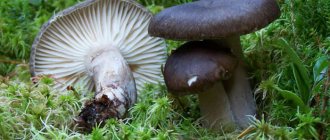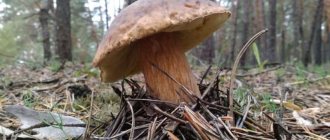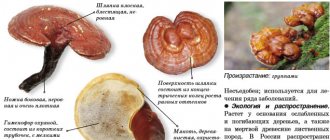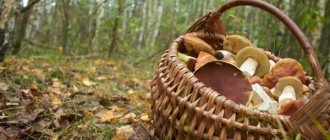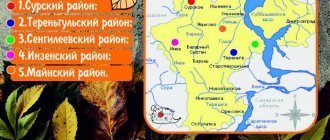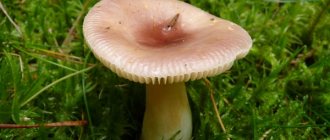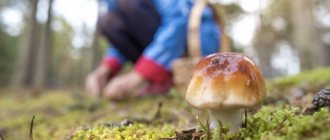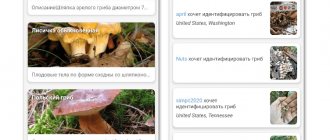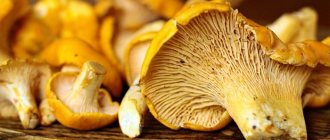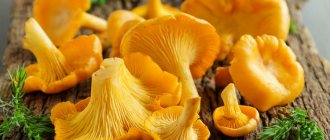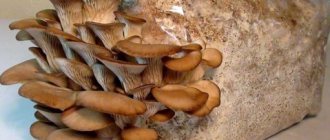It is very easy to become an amateur mushroom picker, especially during the fertile season. The activity calms you down, distracts you from your usual activities, a walk in the forest saturates you with oxygen, and the basket with mushrooms fills up endlessly. Becoming a professional mushroom picker is more difficult. You need to learn to understand the edibility of mushrooms and choose the right places to collect them.
Short description
| Type of mushrooms: | edible |
| Other names (synonyms): | Hygrophorus russula |
| Latin name: | Hygrophorus russula |
| Family: | Hygrophoraceae |
| Distinctive feature: | Hygrophorus russula is an edible mushroom with good taste. Grows in groups, prefers deciduous forests. Forms mycorrhiza with oak. |
| Beginning of the season: | August |
| End of season: | november |
| Leg height (cm): | 4-8 cm |
| Cap width (cm): | 5-10 cm |
| Smell: | mealy |
| Taste: | nice |
| Tasting score: | [kkstarratings] Have you tried this mushroom? Then rate it! |
| Hat: | fleshy, compacted, initially hemispherical, convex, with curved edges, later convex-prostrate. The skin is smooth, with small scales, sticky, sometimes with cracks. The color when the mushroom is young is almost white, pale pink, when ripe it is reddish, red-violet, with a dark center, with spots. |
| Leg: | 1-2 cm thick, strong, cylindrical, curved, narrowed towards the base and widened towards the bottom. Dirty pink with purple spots. |
| Hymenophore (bottom of cap): | the plates are frequent, adherent to the stem. Whitish, later spotted pink. |
| Disputes: | elliptical, (7) 6.1-7.9 (8.8) x 4.2-5.1 µm. |
| Pulp: | white, turns red when cut. |
| Natural environment and mycorrhiza: | in deciduous forests. |
| False doubles: | Reddening hygrophorus is distinguished by its smaller cap, which is more mucilaginous, has a bitter taste and purple scales. |
| Growing: | – |
| Use: | used fresh, as well as salted and pickled. |
| Medicinal properties: | – |
| Spreading: | North America, Europe, Africa. |
Description of the appearance of the mushroom
Hygrophorus russula belongs to the Hygrophoraceae family. It is an edible mushroom. Latin name: Hygrophorus russula. Among mushroom pickers it is known as “Russula hygrophorus”.
hat
Its cap is strong and fleshy, which is why the mushroom is valued. It has a convex shape at the growing stage, and in adulthood it becomes more even and prostrate. In the central part there is a tubercle and thickening.
The surface is slightly wavy, the skin is scaly. The edges of the cap are tucked towards the stem. The color ranges from dark pink to purple, with the central part being darker to match the color. Reaches a diameter of 11 cm, more often 5-8 cm.
Hymenophore
The hymenophore has sparse, narrow main plates with a large number of intermediate plates. In “youth” they are white in color, and with the advent of maturity they become more purple. The spores resemble an ellipse shape. Smooth, white.
Pulp
The pulp is white, dense, practically odorless and tasteless.
Leg
The leg is thick and strong, has a cylindrical shape with thickening downwards. Length reaches 12 cm, width up to 4 cm. Dense and fibrous, with a smooth surface. White, below – pink with reddish dots.
Interesting Facts
Hygrophorus russula.
The genus Hygrophora includes about 40 species of mushrooms. None of them are poisonous. All hygrophora mushrooms are harmless, but some are inedible due to their smell or taste. Most hygrophores can be eaten.
However, even harmless mushrooms can cause digestive problems if consumed by people with chronic pathologies of the gastrointestinal tract. Also, children should not eat mushrooms (their digestive system is not yet ready to digest such heavy food as mushrooms). This product is not recommended for pregnant women, breastfeeding women and people with allergies.
Growing mushrooms in the country and at home
To grow hygrophorus in the country, you will need mycelium. It can be purchased in powder form in specialized stores. One package is designed for sowing 1 m2. Pay attention to the expiration date. The seeds are mixed with dry soil or sand and planted under a suitable tree.
The soil must be prepared. To do this, remove a layer of soil up to 15 cm and loosen it. Pour the mixture with mycelium, evenly distributing it, onto the surface and finish with a layer of native forest or garden soil with humus. The planted plot of land needs to be watered abundantly (10 liters of water per 1 m2 of area).
You can sow mycelium all year round. Harvesting is possible up to 4 times - twice in the spring and the same amount in the fall. Fertilize the soil once a year during the period when the mushrooms have finished growing. This will help maintain high yields. This species can also be grown indoors indoors, just like champignons.
Useful properties of tinder fungus
The idea of collecting tinder fungi for the purpose of subsequent consumption seems strange only for the first time.
In fact, the name “tinder fungi” includes a huge variety of fungi, of which the woody hoof-like growths on trees are only a minority. In general, the very concept of “tinder fungi” is known to science only indirectly, as something meaningless and amateurish. According to science, tinder is a genus of woody perennial fungus, from which tinder was once made. Everything else is called something else. In the popular concept, a “tinder fungus” is something that grows on a tree and does not look like an ordinary “cap” mushroom. There are also terrestrial polypores (in fact, rather special oyster mushrooms) - the genus Polyporus. They look like tubular ones (and their hymenophore is completely tubular), but the rubbery-inextricable flesh will not allow you to make a mistake. Among the polypore "tinder fungi" there are many edible ones. But first things first.
Cut tinder fungus.
The most popular tinder fungus among people is the sulfur-yellow tinder fungus. People (not ours) call it “witch’s oil,” and for good reason. At the end of May, take a walk through the deciduous forest, look for old oaks and lindens - you will probably see on one or two a lumpy, jelly-like mass of sulfur-yellow color, as if runaway dough. You can see it from afar on the dark trunks of the open oak forest! If found, congratulations; So we met the sulfur-yellow tinder fungus in its edible form. Now all you have to do is take out a knife, cut out the pulp (while it is still pulp), and go home - either to fry, or to salt, or to stuff into pies. A universal mushroom, very valuable in the relative “mushroom-free” conditions of early summer.
Another famous edible tinder fungus is the ram mushroom. (In fact, there are a number of celebrities of this level: Grifola umbelata, the famous “mushroom cabbage” Sparassis crispa.)
Grifola mushroom.
A very interesting, although quite rare, is the “tinder fungus” called the liverwort. In autumn, meat-red tongues of the fungus appear on damaged trunks of linden and oak trees; the physiological sensation intensifies when cut - more meat than mushroom. Drops of red juice that look like blood. It seems as if the tree has sinned deeply in some way and is now being punished by the forest gods. However, this does not stop people from collecting young liverworts and eating them. They write that it is healthy, with vitamins.
Finally, the most “culinary” and widespread genus of tinder fungi is Polyporus. As a rule, these are cap mushrooms with a tubular hymenophore; their edibility is inversely proportional to the degree of hardness of the fruiting body. For example, the “spider,” a scaly tinder fungus that appears in early summer, is relatively soft and therefore edible. Even softer and more edible is the small tuberous tinder fungus, characterized by wide pores. But the May tinder fungus is, in a sense, a transitional form between food and technical tinder fungi. When I get a little bit of it, I crumble it into the soup for flavor. It smells good.
False doubles
This mushroom is often mistaken for russula, but the difference is that the hygrophora has less dense and unbreakable flesh.
It can also be confused with hygrophorum blushes. The latter has a smaller cap, covered with mucus with purple scales, and the flesh has a bitter taste. His hat is dome-shaped and his leg is long.
Early
An edible agaric mushroom, the cap of which in diameter can vary from five to eleven centimeters. It is dry, smooth and elastic. In a young mushroom it is painted white with a slight grayish tint, which later changes to leaden or almost black.
The initially convex cap becomes almost flat. It is extremely rare to be depressed. The surface is slightly wavy and curved. The leg is up to ten centimeters high, cylindrical in shape. It is curved, painted gray or white. Under the cap, at the top it is covered with small scales.
The pulp of the early hygrophora mushroom is grayish or white, with a faint odor. This species can be collected in early spring, when other edible agaric mushrooms, as well as inedible ones, have not yet appeared. The active collection period begins in the temperate zone of Europe and North America in early March and continues until mid-May in deciduous and coniferous forests with nutritious soils. This mushroom is usually used to prepare soups and meat dishes.
Taste of hygrophor, benefits and harm
This type of mushroom boasts a rich composition. It includes amino acids, vitamins, plant proteins and minerals. Among the vitamins: PP, B9, B6, B5, B2, B1, choline.
Important: the caloric content of hygrophor is 24 kcal per 100 grams.
Thanks to the individual combination of micro- and macroelements, hygrophor is able to benefit the human body:
- Selenium normalizes the functioning of the thyroid gland, prevents the development of tumors, and has a positive effect on vision;
- manganese supports the functions of the reproductive system, removes unnecessary fatty deposits from the liver;
- copper relieves inflammation, strengthens bones, stabilizes the gastrointestinal tract;
- phosphorus accelerates thought processes, normalizes acid-base balance;
- potassium has a positive effect on sleep, controls water balance, normalizes blood pressure and heart function;
- sodium has a vasodilating property;
- iodine increases physical activity;
- zinc prevents anemia, strengthens the walls of blood vessels;
- sulfur inhibits the aging process;
- Calcium strengthens teeth and participates in muscle contraction.
The mushroom also contains fiber, lysine, cysteine and animal proteins. It has a pleasant taste and goes well with cereals, potatoes, cheese, meat, vegetables and spices.
In addition to its benefits, the mushroom can also have a negative effect on health. You should not use it in your diet too often, as the following manifestations are possible:
- allergic reactions;
- hypervitaminosis, in which the skin condition noticeably worsens;
- chemical damage to cartilage tissue;
- frequent urination;
- cardiopalmus.
Russula
This mushroom has a fleshy cap that is pale pink in color. Russula mushroom is widespread in deciduous forests of the Northern Hemisphere. It has a hemispherical, convex cap, which can be either depressed or flattened, sometimes its edges are tucked. The surface of the cap is smooth, with slight scaliness, often sticky-mucous, pale pink in color, with pink spots. The central part is darker: pinkish-red or wine-red.
Purple-pink plates are often located, the flesh of the mushroom is quite dense, white, turns pink when pressed, and has a faint aroma. The leg is centrally located, slightly tapering downwards. There are russula hygrophores with fusiform or club-shaped legs and a white surface with pinkish-brown spots.
Cooking recipes
Hygrophores can be fried, dried, baked, boiled. They are often added to salads, sauces, side dishes, soups, marinades, and pies.
IMPORTANT! Mushrooms should not remain unprocessed for a long time after picking; they spoil easily. It’s better to start preparing them right away.
Cleaning
The cleansing process is simple. The mushrooms are washed under water, any remaining dirt and leaves are removed, damaged parts are cut off, and dried.
Cooking
The process takes 10 minutes. This procedure is necessary in order to get rid of possible bitterness. Before cooking, the mushroom must be cleaned.
Pickling
For preparation you will need:
- prepared and boiled mushrooms - 2 kg;
- water - 1 l;
- vinegar 9% - 0.4 l;
- salt - 40 g;
- sugar - 10 g;
- bay leaf - 4 pcs.;
- allspice - 4 peas;
- cloves - 5 pieces.
How to cook?
- Sterilize 2-2.5 liter containers and lids.
- Pour salt, sugar, spices into heated water and dissolve, stirring. When boiling, do not reduce the heat for 6 minutes.
- Add vinegar and cook for another 2 minutes over medium heat.
- Immerse the peeled mushrooms in the marinade and cook for a quarter of an hour.
- The final stage is to put it into jars.
Freezing
Peeled mushrooms (do not cut into too small pieces) are boiled in salted water, the liquid is allowed to drain and sealed in bags, removing air.
They do not need to be thawed to use in dishes.
Frying
For fried hygrophores with potatoes and garlic you will need:
- mushrooms - 200 g;
- potatoes - 600 g;
- onions - 2 pcs.;
- vegetable oil - 90 g;
- garlic – 2 cloves, thyme sprig;
- salt to taste.
Step-by-step preparation
- Potatoes are fried until golden brown in vegetable oil.
- Add mushrooms and onions and mix. Close the lid and cook over low heat for 15 minutes.
- Spices are added at the very end.
Salting hygrophores in oil
To prepare the dish you will need:
- mushrooms – 1 kg;
- garlic - half a head;
- allspice – 50 g;
- bay leaf – 8 pcs.;
- dill umbrellas – 3-4 pcs.;
- salt – 50 g;
- sunflower oil, odorless.
Step-by-step preparation
- Mushrooms are boiled in water without adding spices, just adding a little salt, for 20-25 minutes.
- Next, they are placed in a container with their caps down. This is done in layers with salt, pepper, dill and laurel leaves.
- Compact and pour in oil, completely covering the level of mushrooms.
- The salting process lasts at least 30 days. The workpieces should be stored in a cool place.
Drying
Lamellar mushrooms, such as milk mushrooms, hygrophores, russula, volushki, etc., are not dried due to the appearance of a specific bitter taste.
Application
These representatives of the mushroom family are versatile - they can be pickled for the winter, dried, pickled, or cooked as first or second courses. Chinese cooks use hygrophores to prepare a tasty and healthy drink. The only warning from experienced mushroom pickers is that before cooking, be sure to remove the slippery skin along with the mucus, otherwise the mushrooms will taste bitter.
In medicine, alcohol tinctures are prepared from hygrophorus (used in the treatment of cardiovascular diseases, weak immunity, for the prevention of diabetes) and decoctions for lotions (used externally for inflammatory processes). For medicinal purposes, you can use both fresh and dry mushrooms.
hygrophores are a good product for preparing tasty and healthy dishes
In cooking. Cooking methods
Before you start preparing mushroom dishes, the hygrophores must not only be cleaned and the skin and mucus removed, but also thoroughly washed. You can soak it in salt water for several hours. Boil for about a quarter of an hour.
Hygrophores go well with other mushrooms, vegetables and even meat:
- Vegetable casserole with mushrooms. Boil mushrooms and potatoes in advance. Place the mashed vegetable in a thick layer on a baking sheet, cover with mushroom mixture (chop the mushrooms, combine with fried onions and carrots). The top layer is potatoes. Grease with oil and bake in the oven for about half an hour.
- Fried mushrooms. Boil the hygrophores, cut into large pieces, place in a dry frying pan, dry over high heat, add vegetable oil, onion (half rings), and spices. Fry until done.
- Soup. Boil the mushrooms and remove from the broth. Place potato cubes in the liquid and boil for 10 minutes. Cut the hygrophores into small pieces and add to the soup. Fry onions and carrots in oil, combine with almost finished soup, add spices.
You can prepare a sauce based on hygrophorus - puree the boiled mushrooms in a blender (it’s better to leave small pieces), add tomato sauce, spices, a little water and cream, bring to a boil and immediately remove.
mushrooms have medicinal properties and are used in traditional medicine recipes
In medicine
The most popular in folk medicine is tincture. It is better to prepare it from fresh mushrooms. Recipe:
- Wash the hygrophores, cut into large pieces, and place in a glass bottle.
- Pour in alcohol (you can use homemade first aid), the alcohol component should slightly cover the mushroom mass.
- Leave the tightly sealed container in a cold room for a month.
After straining, store in the refrigerator. Take 15 ml twice a day to strengthen the immune system, prevent diabetes or for heart disease, preferably on an empty stomach.
To treat skin inflammation, it is recommended to use a concentrated decoction:
- Pour boiling water over dry mushrooms (600 ml of water per 50 grams of raw materials).
- Place the container in a steam bath, simmer the mushroom mass for about half an hour, do not open the lid.
- Remove, leave until completely cooled, strain.
Soak a soft cloth in warm broth, place it on the affected area of skin, and leave for half an hour. Repeat every day.
For problems with the digestive tract, it is recommended to consume boiled mushrooms (50 g) daily. It is forbidden to add aromatic spices and salt - fresh hygrophores will be the most useful.
salted hygrophores have a good taste and a long shelf life
“Neither the onion nor the worms will show the edibility of the mushroom”
– Is it possible to determine whether a mushroom is edible or not, in the field or at home?
- No! It is impossible to determine the edibility of an unknown mushroom by smell or taste. For example, the toadstool tastes sweet. The traditional method of boiling mushrooms with an onion that either turns blue or not, doesn’t work either. You need to take only those mushrooms that you know well. I recommend picking mushrooms together with the cap and stem, so as not to be mistaken in identifying the species. For example, among the mushrooms of the spider web family there are many poisonous species and species with unknown nutritional properties. Poisonous ones have a light cobweb on their legs when they are young.
– Some people believe that if worms eat a mushroom, then humans can eat it too. This is true?
– No, worms eat both edible and inedible mushrooms. But chanterelles, for example, don’t eat.
– Can you eat the lines?
- No, this is a poisonous mushroom, the poison gyrometrin accumulates in it, it does not decompose when cooked.
- And the pigs? Many people eat them all their lives, and nothing bad happens.
– According to the latest data, eating them is not recommended. They contain substances that have a cumulative effect. Up to a certain point, nothing happens to the human body, and then they can “shoot.”
– In folk medicine there is a way to get rid of parasites - eat one raw chanterelle a day. What mushrooms can be eaten raw? Russula, maybe?
- None! Only champignons grown on a farm under ideal conditions can be eaten raw. All other mushrooms must be at least boiled before use, for at least ten minutes.
– If a mushroom is slightly wormy, can it be eaten?
- Undesirable. Worms release harmful substances during their life.
– Cut with a knife or twist?
– There is no clear opinion on this matter. Our ancestors said: they take mushrooms. So you can take them, you can twist them, the main thing is not to disturb the integrity of the litter or the upper soil horizon. This affects fruiting.
– Is it true that the more often you pick mushrooms, the more of them grow?
- Yes. There is a body of a fungus - this is the mycelium, mycelium, it is located in the soil, and its reproductive organs are mushrooms, fruiting bodies that we collect. Collecting fruiting bodies stimulates fruiting of the mycelium.
Definitioner
Basidia (Basidia)
Lat. Basidia. A specialized structure of sexual reproduction in fungi, unique to basidiomycetes. Basidia are terminal (end) elements of hyphae of various shapes and sizes, on which spores develop exogenously (outside).
Basidia vary in structure and method of attachment to hyphae.
Based on the position relative to the axis of the hyphae to which they are attached, three types of basidia are distinguished:
Apical basidia are formed from the terminal cell of the hypha and are located parallel to its axis.
Pleurobasidia are formed from lateral processes and are located perpendicular to the axis of the hypha, which continues to grow and can form new processes with basidia.
Subbasidia are formed from a lateral process turned perpendicular to the hyphal axis, which stops growing after the formation of one basidium.
Based on morphology:
Holobasidia are single-celled basidia, not divided by septa (see Fig. A, D).
Phragmobasidia are divided by transverse or vertical septa, usually into four cells (see Fig. B, C).
By type of development:
The heterobasidium consists of two parts - the hypobasidium and the epibasidium developing from it, with septations (see Fig. C, B) or without them (see Fig. D).
Homobasidia is not divided into hypo- and epibasidia and in all cases is considered to be holobasidium (Fig. A).
The basidium is the site of karyogamy, meiosis, and the formation of basidiospores. Homobasidy, as a rule, is not functionally divided, and meiosis follows karyogamy. However, the basidia can be divided into probasidium, the site of karyogamy, and metabasidium, the site of meiosis. Probasidium is often a resting spore, for example in rust fungi. In such cases, the probasidium germinates into a metabasidium, in which meiosis occurs and on which basidiospores are formed (see Fig. E).
See Karyogamy, Meiosis, Hypha.
Pileipellis
Lat. Pileipellis, skin - a differentiated surface layer of the cap of agaricoid basidiomycetes. The structure of the skin in most cases differs from the inner flesh of the cap and may have a different structure. The structural features of pileipellis are often used as diagnostic characters in descriptions of fungal species.
Based on their structure, they are divided into four main types: cutis, trichoderma, hymeniderma and epithelium.
See Agaricoid fungi, Basidiomycete, Cutis, Trichoderma, Hymeniderma, Epithelium.
Pileipellis (Pileipellis)
Lat. Pileipellis, skin - a differentiated surface layer of the cap of agaricoid basidiomycetes. The structure of the skin in most cases differs from the inner flesh of the cap and may have a different structure. The structural features of pileipellis are often used as diagnostic characters in descriptions of fungal species.
Based on their structure, they are divided into four main types: cutis, trichoderma, hymeniderma and epithelium.
See Agaricoid fungi, Basidiomycete, Cutis, Trichoderma, Hymeniderma, Epithelium.
Ixotrichoderma
Trichoderma, consisting of hyphae immersed in mucus. The surface of the cap is oily, slippery or slimy.
Lat. Ixotrichoderm.
See Trichoderma, Hypha.
Ixocoutis
Cutis, consisting of hyphae immersed in mucus. The surface of the cap is oily, slippery or slimy.
Lat. Ixocutis.
See Kutis, Gifa.
Fragrant (fragrant)
An edible mushroom with a strong odor, which gives rise to its name. The cap of the fragrant hygrophorus is medium in size (no more than ten centimeters in diameter). It is painted brownish or gray, and the edges are usually lighter than the center. The surface is smooth or slightly sticky. Young mushrooms have convex caps, but over time they become flat.
The gray leg is from four to twelve centimeters high, noticeably lighter than the cap. It has a cylindrical shape. There are specimens with flattened legs covered with scales along their entire length. The flesh of this mushroom is gray or white, sometimes has an olive tint. It is soft and crumbly, slightly watery. The strong almond smell, which gives the mushroom its name, can be felt in damp weather if you are a meter away from the mushroom. This hygrophore can often be found in the Far East from the end of August until the first days of October in pine-spruce forests on calcareous soils. Occasionally found near firs. It has an excellent taste when salted and pickled.
Larch
This hygrophorus mushroom has a very noticeable cap of bright lemon or yellow color. It is spread out and covered with a fairly large layer of mucus. The cylindrical leg, which thickens slightly at the base, grows up to eight centimeters.
Sometimes you can see mucus threads connecting the stem to the cap. The plates are slightly lighter than the cap. The pulp is white or has a light yellow tint. These mushrooms are collected from the beginning of August until the very end of September in southern European countries. Most often found under larches. In cooking it can be used in almost any form.
Late (brown)
This is an edible hygrophorus mushroom, the description of which can often be found in special publications. The small cap (from three to seven centimeters) is colored olive or brownish-brown. It is slightly convex, with the edges turned inward. The surface is mucous, the edges are much lighter than the central part.
It is thanks to the cap that the brown mushroom is so called. The yellowish or olive solid leg can be from four to twelve centimeters. In old mushrooms it is often hollow. The young hygrophorus brown mushroom has a ring that disappears over time.
The light orange or yellow plates are thick and sparse and weakly adhere to the stem. The pulp does not have a pronounced odor and is quite fragile. It is completely white in the cap, and yellowish in the stem. This variety is collected from mid-September until the last days of November. It is interesting that this mushroom appears even after the first snow has fallen, so it also has a second name - late.
Reddish
The reddish hygrophorus mushroom has a classic appearance: a dome-shaped cap and a rather long stem. A fully ripe mushroom opens its cap. Its surface is pinkish with rare yellow spots. It is uneven both in texture and shade. In August or September, this mushroom is easy to find in mixed or coniferous forests. Most often it appears under pine or spruce trees, with which it coexists perfectly.
Despite the fact that this mushroom is used as food, it should be recognized that it does not have a special smell or taste; it is more often used as a supplement. Externally, this hygrophorus resembles Russula. It is almost the same, but thicker and larger. Professional mushroom pickers carefully examine the plates to detect differences.
